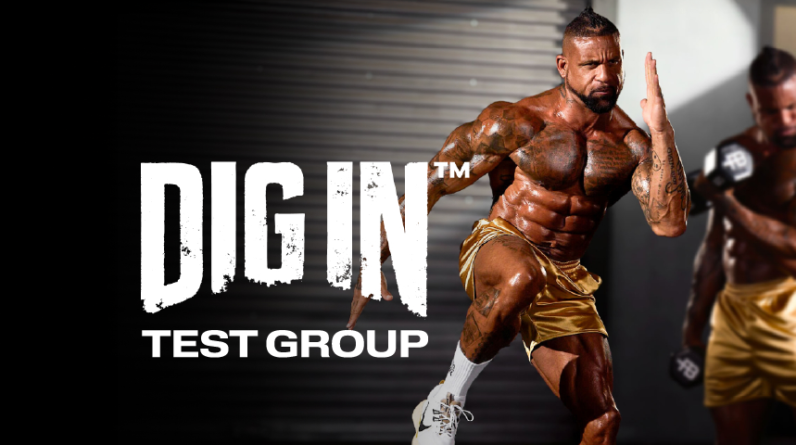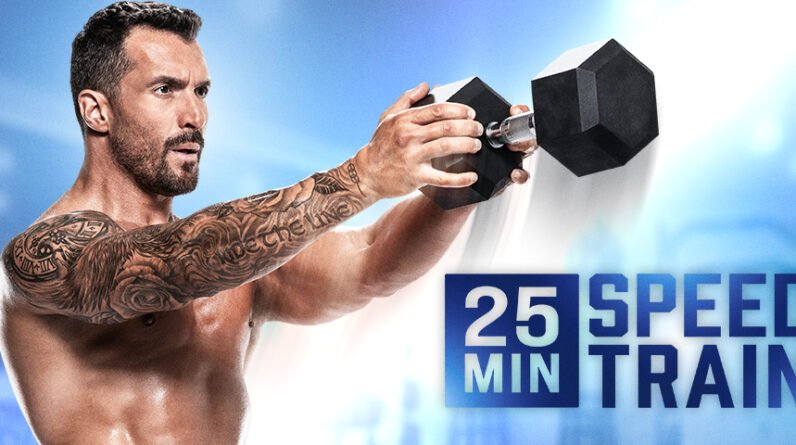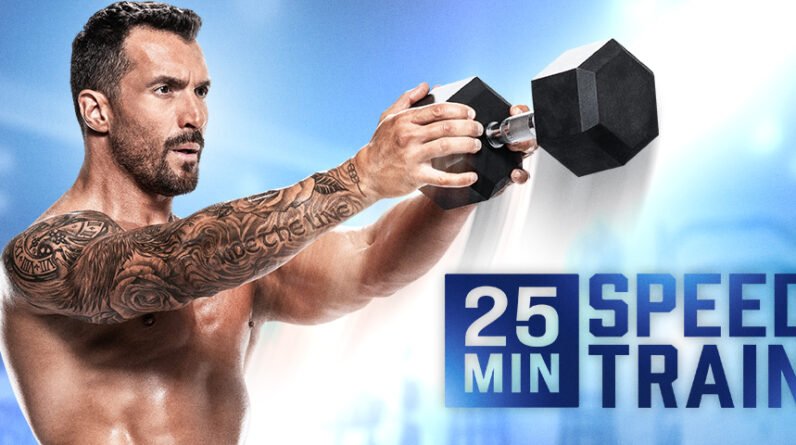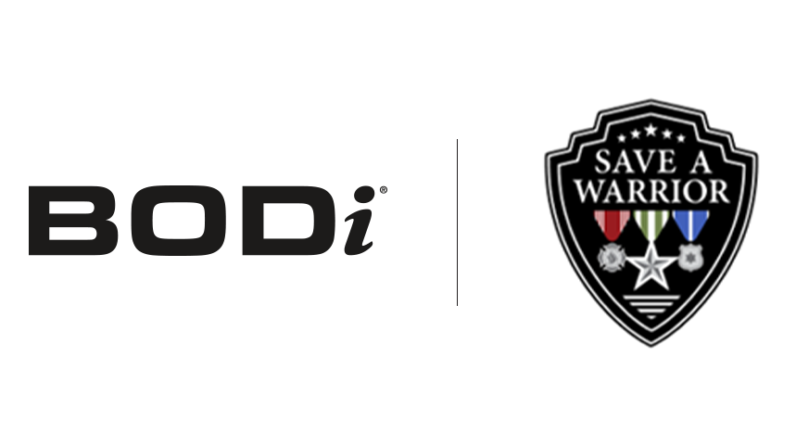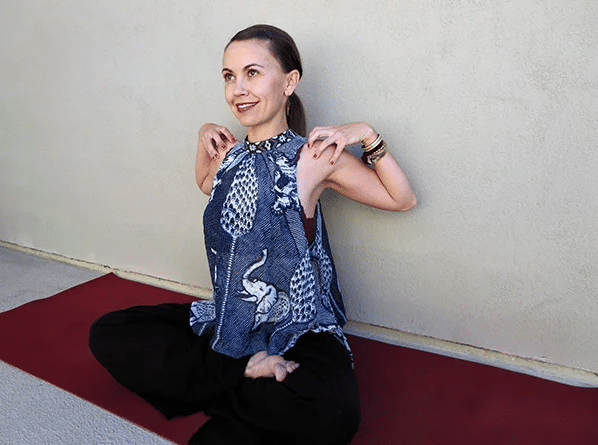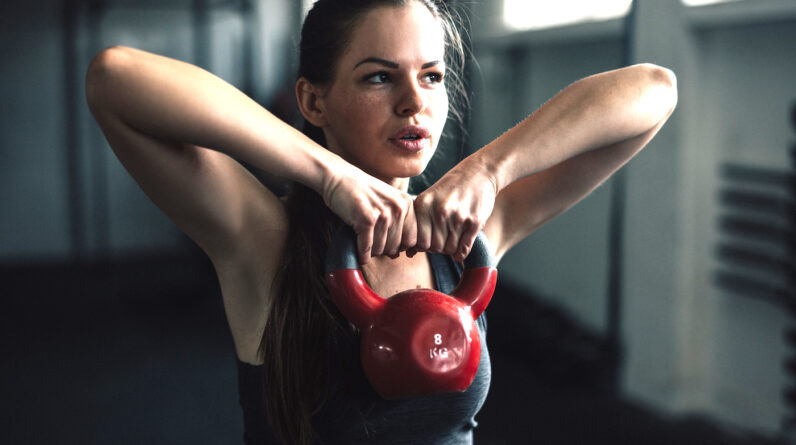
What is a Romanian deadlift?
A Romanian deadlift is typically classified as a compound exercise that works several muscle groups at once. The full-body move—which you’ll find as a mainstay in many strength training workouts—is an amped-up version of the old-fashioned deadlift, and is characterized by an increased range of motion from your knees. The movement is often performed with a barbell, but you can use a pair of dumbbells, kettlebells, or resistance bands, too.
What muscles does it work?
When performed correctly, the weighted workout will hit the hamstrings, core, and glutes in one fell swoop. If you’re just starting out, you might want to go lighter on the weights and work your way up gradually—and more importantly, learn the proper Romanian deadlift form to reap the benefits of the exercise and avoid injury.
What’s the difference between a regular deadlift and a Romanian deadlift?
There are a number of different types of deadlifts out there—from single-leg deadlifts to Sumo deadlifts—but they’ve all got the same general idea: to lift a weight along the front side of your body using your core and posterior chain. Romanian deadlifts are one of many types of moves that fall into this umbrella category. Unlike moves that share its name, the Romanian deadlift is super targeted to hit your glutes and hamstrings hard.
With a regular deadlift, you grab a weight up off of the floor and pull it up to stand, using the muscles in your glutes and core. A Romanian deadlift, however, starts with the weight at your hips, which creates a smaller range of motion. “Romanian deadlifts tend to target the hamstrings and the move is dependent on hamstring and hip strength,” says Training Mate founder Luke Milton. “Usually the Romanian Deadlift is performed with a lighter weight than a standard deadlift and is focused on the eccentric lowering motion, as opposed to the deadlift, which has a concentric lifting focus.”
Because you’re lowering the weight down against gravity instead of lifting it up off of the floor, the move requires you to engage your glutes and hamstrings in a completely different way. And, bonus? It will also hit your core and forearm flexors with each and every rep.
How to build up to a Romanian deadlift
Before you grab a weight and get to work, there are a few things to keep in mind. Most importantly? You’ll want to start light. Since this move is more targeted than your conventional deadlift, you’ll want to take things down a notch with how heavy you’re lifting. Use lighter weights than you would for a traditional deadlift and work up your strength until you’re able to progress to some higher pounds. “Start with lighter weights—whether that’s a dumbbell or a kettlebell—as you build up grip strength,” says Katie Kollath, CPT, and co-founder of Barpath Fitness. The move is traditionally done with a barbell, but you can swap in a dumbbell, kettlebell, or long resistance band if you want to work with something lighter (or if that’s all you’ve got at home).
Another way to work your way up to the full expression of the move is to practice with single-leg Romanian deadlifts, in which you’ll keep one leg planted on the floor with the other extended out behind you as you lift. “This variation requires much more unilateral stability,” says Kollath. This will help you become accustomed to the lowering motion, and make it easier when you work your way up to trying it with two feet flat on the floor.
The biggest mistakes people make in their Romanian deadlifts
1. Using weight that’s too heavy
While you may think you’ve got lifting your usual set of heavies down pat, trying to use them in your Romanian deadlift can lead to problems. “Because the Romanian deadlift requires such hip and hamstring strength, the overload of heavy weights combined with inadequate strength of the hamstrings and hips usually leads to a sore lower back,” says Milton. Plus, it will prevent you from being able to do the move properly, which totally defeats the purpose in doing it at all.
2. Rounding your spine
It may take some getting used to, but it’s important to keep your spine completely straight as you lower down into the move. “You want to lower the bar down while maintaining spinal extension—aka a flat back—and only go as low as you can while keeping that position,” says Kollath. “As soon as you feel or see rounding in the spine, you’ve got too far.” How low you’ll be able to go is completely dependent on your individual body. According to Kollath, some people will need to stop just under the knees while others will have the ability to lower to the shins or even the floor—but it’s important to pay attention and stop as soon as you feel your form start to sacrifice.
3. Looking up
“As people attempt to engage the lats and keep the back tight, they may look up and cause stress on the cervical spine,” says Kollath. To avoid this, you’ll want to keep your gaze fixed out in front and slightly downward, which will help keep your head and neck in alignment with the rest of your spine.
4. Locking your knees
While there is a version of a deadlift that requires you to keep your legs straight (called a “stiff-leg deadlift”), you want to make sure they stay nice and loose for this variation of the move. “Be sure to keep your legs bent as this can lead to injury,” says Kollins Ezekh, ACE-CPT. Locking your knees is a major no-no, too, as that’s another surefire way to hurt yourself.
A step-by-step guide for proper Romanian deadlift form
1. Start standing with your knees slightly loose with the barbell (or whatever you choose to use for a weight) held squarely in front of your hips. Focus on engaging your lats by squeezing your shoulder blades back and down.
2. Initiate the movement by pushing your hips and glutes back and keeping your knees slightly bent.
3. Keep the weight close to your body as you bend forward, and go as far down as you can without rounding your upper back in the process. Keep your gaze looking straight ahead to ensure you’re keeping your back straight as you bend over.
4. Drive your hips forward and squeeze your glutes as you stand back up to start.
How to know if you’re doing a Romanian deadlift correctly?
Performing a Romanian deadlift is one thing, but doing it correctly is something else altogether. If you want to know whether you’re maintaining the proper form, you will feel the tension primarily in your hamstring, glutes, and adductor muscles, the last of which are the muscles along your inner thighs. Additionally, you might want to incorporate trainer-approved deadlift form tips, including visual cues, to help you move through the motions of the exercise seamlessly and safely.
Romanian deadlift alternatives
If you want to shake up your workout, or simply want an alternative to the Romanian deadlift, there are several deadlift variations that are just as effective for working your back muscles and lower body and increasing your overall strength.
1. Single-leg deadlifts
A single-leg deadlift is a unilateral movement that not only works the posterior chain, but also tests your balance. According to trainer and Le Sweat founder Charlee Atkins in a previous interview with Well+Good, the exercise works to target the glutes and hamstrings. Another pro tip from Atkins? Hold your weight on the same side as your working leg—this will ensure your hips stay squared and you get the most from the exercise.
How to perform the movement:
1. Start with both feet under your hips.
2. Bend forward at the hips and while keeping your back straight, lift one leg off the floor.
3. Bring your leg back down to return to the starting position.
4. Perform as many repetitions as you would like before moving onto the other side.
2. B-stance deadlifts
A B-stance deadlift is similar to a single-leg deadlift, working the hamstrings, glutes, and back. The difference is that you don’t have to lift your leg when performing the movement—which makes it ideal for those who are new to the exercise.
How to perform the movement:
1. Start with your feet hips-width apart.
2. Stagger your stance by placing one leg behind the other, ensuring that the big toe of your back leg is in line with the heel of your front leg.
3. Hold your weights at the front of your thighs and hinge your hips back without rounding your spine.
4. When you reach mid-shin, reverse the movement by thrusting your hips forward to your start position. Repeat.
3. Sumo deadlifts
While a sumo deadlift can make a great alternative to a Romanian deadlift, “this will work your quads and your hamstrings more than your back and core,” says LaNiecia Vicknair, corrective exercise specialist and founder of Los Angeles-based boutique gym Thrive Health Lab.
How to perform the movement:
1. Start with your feet wider than hip-width apart and your toes pointed outwards at a 45-degree angle.
2. Hinge forward from the hips with a flat back and pick up your weight.
3. Bend your knees and lift the weight while pressing the soles of your feet into the ground, then push your hips forward to bring you up to standing position.
4. Bring the weight back to the ground and repeat.
4. Good mornings
Good mornings are another movement to wake up the hamstrings and strengthen the lower back. This exercise calls for you to place the weight on your shoulders, whether you’re using a pair of dumbbells or a looped band.
How to perform the movement:
1. Stand with your feet hip-width apart.
2. Carefully prop up a pair of dumbbells and place them on your shoulders—or if you’re using a looped band, rest them on your traps.
3. With your shoulders pulled back and knees slightly bend, hinge back with your hips and bend forward into a 90-degree angle.
4. Reverse the movement and push your hips forward, squeezing your glutes at the top. Repeat.
What are the benefits of deadlifting?
No matter which variation you plan on trying, the benefits of deadlifting make it worth a spot in your movement routine. First, they can strengthen your posterior chain and core—and in turn, can even improve your posture over the long run. And because they work various muscle groups simultaneously, deadlifts are an effective and time-efficient movement. Plus, they can be adjusted to suit your body’s needs as well as your fitness level.
Frequently asked questions
Are Romanian deadlifts safe?
When performed with the proper form, Romanian deadlifts are a safe exercise to incorporate into your routine. It’s also important to keep in mind that if you’re new to the movement, you might want to work your way up from lighter weights to prevent unwanted injury.
Are Romanian deadlifts back for your back?
For as long as you’re doing them correctly, Romanian deadlifts won’t put unnecessary strain on your back, but rather, strengthen it. If you have any injuries or notice pain when attempting to perform the exercise, opt to consult with your doctor and/or trusted physical trainer to ensure that it’s safe for you to perform.


